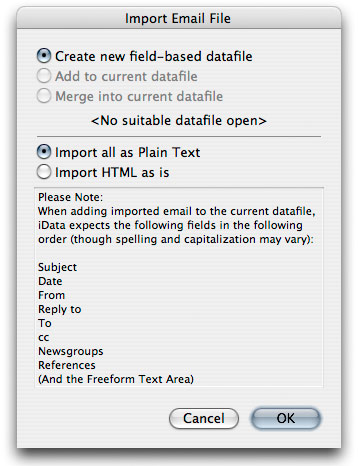1. If you wish to add the incoming file to an existing datafile, open that datafile and make sure it is the frontmost datafile in iData Pro. (If the datafile is already open, and if it has had any changes made to it, it would be a good idea to save those changes before proceeding.)
2. Select the kind of email you want to import from the Import sub-menu under the File menu.
3. In the Open dialog that comes up next, navigate to your mbox file, select it, and click the Open button.
4. The following dialog will appear. If there is no current datafile open, only the first radio button will be active.

5. If applicable, select one of the radio buttons. Here are what the options mean:
a. Create new field-based datafile - As you might expect, this will create a new datafile containing the imported email data. You will be able to save the new datafile with any name you desire. Newly created email datafiles will have the Freeform Text Area renamed as "Message".
b. Add to current datafile - If this option is available, it will cause newly imported records to be added at the end of the current datafile. If you are importing a later version of the mailbox that was used to create the current datafile, you will probably end up with duplicate records. Therefore, this option is best for adding messages from different mailboxes into a single datafile.
c. Merge into current datafile - If this option is available, after adding the newly imported records, iData Pro will automatically remove all exact duplicates, so this is probably the best option for repeatedly updating a datafile for a particular mailbox. Note that removing duplicates requires that the datafile be sorted by the contents of all the fields in order, so if you have rearranged the datafile for any reason, that order will be lost.
6. Click the OK button to start the import.
7. Once the import is complete, if you selected the first option, the result will be a new untitled datafile. In this case, we recommend that you save the new datafile right away, giving it the same name as the mailbox from which it was imported, but retaining the required .id3 file name extension.
Import Speed:
Depending on the speed of your particular
machine and the percentage of html-based messages, importing a mailbox
with, say, 2000 messages may take anywhere from 20 seconds up to about
2 minutes. Html messages take longer than plain text, as they require
an additional translation stage.
Old HTML messages that contain links to images that no longer exist on the Web are a particular problem, as the system may spend as much as a minute (which feels like forever) trying to find the image before giving up. In a few cases, the system will not be able to process such a message, and will return an error code. In these cases, iData will place a message saying, "HTML could not be processed." in the Message area.
If it seems that the import is going on for longer than normal, you can abort the import process at any time by typing the esc key or command-period. However, if you know that the mailbox being imported is large, it's probably best to be patient.